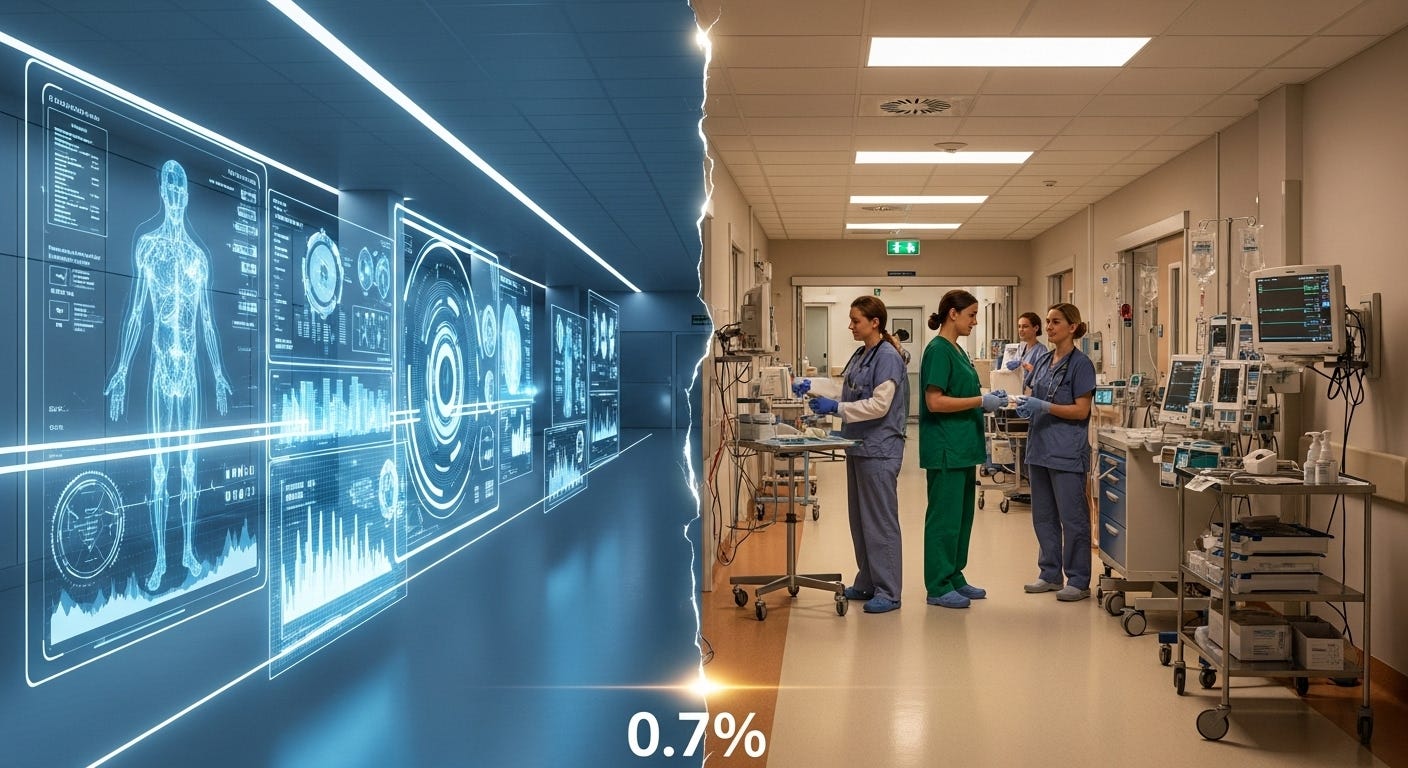The 99.3% Problem
Why China's World-Class Medical AI Isn't Actually Being Used
China has built AI that can diagnose diseases with 93% accuracy and analyze 3,000 pathology slides daily. So why do only 0.7% of hospitals actually use it?
Picture this: An AI system that can diagnose respiratory diseases with the same accuracy as a seasoned physician. Another that processes thousands of medical scans in the time it takes a doctor to analyze just one. Advanced algorithms that have been trained on hundreds of thousands of patient cases, achieving near-human performance on medical licensing exams.
This isn't science fiction. It's happening right now in China. But here's what reveals everything wrong with how we think about AI in healthcare: despite having some of the world's most advanced medical AI, only 0.7% of Chinese hospitals actually use these systems.
This is the 99.3% problem. The hidden truth about why breakthrough technology and real-world adoption are two completely different challenges.
The Tale of Two AIs
China isn't pursuing just one path to AI-powered healthcare. Instead, it's running a fascinating dual-track experiment that shows two fundamentally different philosophies about how to integrate artificial intelligence into medicine.
The Revolutionary Path: Tsinghua's Agent Hospital
Imagine building a hospital that exists entirely in virtual space, where every doctor, nurse, and patient is an AI agent. That's exactly what Tsinghua University has created with their Agent Hospital. It's a digital simulacrum where autonomous "doctor agents" treat hundreds of thousands of synthetic patients, learning and evolving at superhuman speed.
Their MedAgent-Zero framework is remarkable in its ambition. These AI doctors can accumulate years of clinical experience in just days, treating case after case in their virtual world. The results are impressive: 93.06% accuracy on medical licensing exam questions, with the ability to select appropriate examinations 88% of the time and make correct diagnoses 95.6% of the time.
What makes this approach brilliant is its use of synthetic data. Instead of struggling with messy, incomplete real-world medical records, these AI agents learn in a "clean" environment where every parameter is known and controlled. It's medical AI training in a sterile laboratory, designed to create the perfect digital physician.
The Pragmatic Path: DeepSeek's Plug-In Strategy
While Tsinghua dreams of rebuilding healthcare from scratch, DeepSeek has taken the opposite approach: work with what exists. Their powerful medical AI is deployed directly onto hospital intranets, integrating with existing systems and workflows to solve immediate problems.
The results are equally impressive but in a completely different way. At Shanghai's Ruijin Hospital, DeepSeek's AI analyzes 3,000 pathology slides daily, reducing the time needed for diagnosis from 40 minutes to just 10. At other hospitals, it auto-generates 80% of medical documentation and achieves 95.2% accuracy in differentiating lung nodules.
DeepSeek's strategy is brilliantly practical: keep sensitive patient data secure behind hospital firewalls while delivering immediate value. It's medical AI that plays nice with existing systems rather than demanding they be rebuilt.
Why is China running two completely different AI strategies at the same time? This audio explores the strategic logic behind the dual approach and what it could reveal about a plan for healthcare AI globally:
The 0.7% Reality Check
Here's where the story takes a dramatic turn. Despite these technological marvels, despite AI that can match human physicians in diagnostic accuracy, the national adoption rate across Chinese hospitals is a sobering 0.7%.
Think about that number for a moment. If these AI systems are as revolutionary as they appear, why aren't they everywhere? Why hasn't this technology swept through China's healthcare system like smartphones swept through society?
The answer reveals the most important lesson about AI in healthcare: the hardest problems aren't technological. They're systemic.
This is the 99.3% problem. It's not about the 0.7% of elite hospitals successfully deploying AI. It's about the vast majority who aren't, and understanding why perfect technology fails in imperfect systems.
Why Perfect AI Fails in Imperfect Hospitals
The barriers preventing widespread adoption aren't what you'd expect. They're not about building better algorithms or achieving higher accuracy scores. Instead, they're about the messy realities of how healthcare actually works.
The Data Quality Nightmare
AI models that perform brilliantly on curated data from Shanghai's top hospitals often stumble when exposed to the inconsistent, incomplete records from rural clinics. There's no unified standard for medical examinations across China's thousands of hospitals. What passes for a CT scan in one facility might not meet the criteria of another.
This creates a vicious cycle: AI needs good data to work well, but hospitals with poor data quality are often the ones that need AI assistance most. The technology that could help bridge healthcare gaps instead risks widening them.
The Liability Black Hole
Perhaps the most paralyzing challenge is a simple question that no one can definitively answer: When an AI system makes a mistake, who's responsible?
Is it the software developer who built the algorithm? The hospital that deployed it? The doctor who followed its recommendation? This "responsibility gap" creates enormous legal and ethical uncertainty that makes risk-averse hospital administrators extremely reluctant to adopt AI systems, regardless of their proven accuracy.
The Trust Deficit
Even when AI systems work perfectly, they often fail the human test. Many algorithms operate as "black boxes." Their reasoning is opaque even to experts. Doctors are understandably reluctant to stake their patients' lives and their own professional reputations on recommendations from systems they can't understand or verify.
The contradiction is stark: AI systems designed to support physicians often end up alienating them instead.
The Digital Divide
The computational power required for advanced AI is immense. So much so that training at Beijing Tsinghua Chang Gung Hospital reportedly caused power outages. The costs of implementation and maintenance create a clear winner-takes-all dynamic, where 84% of AI deployments happen at well-funded urban hospitals.
This threatens to create a two-tiered healthcare system where AI amplifies existing inequalities rather than addressing them.
What This Means for Global Healthcare AI
China's experience offers crucial lessons that extend far beyond its borders. Every country pursuing AI in healthcare faces variations of the same fundamental challenge: the gap between technological capability and practical adoption.
The conventional wisdom in tech says that if you build something 10x better, adoption will follow naturally. But healthcare AI reveals why this thinking is flawed. You can have AI that's dramatically more accurate than human physicians, and it still won't matter if hospitals can't trust it, afford it, integrate it, or take legal responsibility for it.
This reframes the entire global competition in healthcare AI. Success won't go to whoever builds the smartest algorithm in isolation. It will go to whoever solves the hardest problems: data governance, regulatory frameworks, clinician trust, and economic sustainability.
The Hidden Opportunity
While the 0.7% adoption rate might seem discouraging, it actually represents an enormous opportunity. China's experience shows that the technical problems are largely solved. The remaining challenges are about systems, processes, and human factors.
This means that companies and countries focusing on seamless integration, explainable AI, clear liability frameworks, and equitable access might have significant advantages over those chasing marginal improvements in algorithmic performance.
The Hybrid Future (If We Can Get There)
The most interesting possibility is that China's dual-track approach isn't fragmented strategy. It's sophisticated hedging. The revolutionary Agent Hospital pushes the boundaries of what's possible, while DeepSeek's pragmatic approach addresses immediate needs and builds adoption infrastructure.
The optimal future likely involves convergence: the advanced, specialized doctor agents perfected in Tsinghua's virtual world eventually deployed through DeepSeek's secure, scalable architecture. Imagine AI physicians trained to theoretical perfection in simulation, then integrated seamlessly into existing hospital workflows.
But reaching this hybrid future requires solving the 99.3% problem. It demands clear regulatory frameworks that address liability concerns, national standards that ensure data interoperability, and targeted investments that prevent AI from exacerbating healthcare inequalities.
The path forward isn't about building better AI. It's about building better systems for AI to work within.
The Global Stakes
China's bold experiment in healthcare AI offers a preview of challenges every nation will face. The country that successfully navigates from 0.7% adoption to widespread deployment won't just transform its own healthcare system. It will export a proven model to the world.
The race for the future of healthcare isn't really about artificial intelligence. It's about artificial intelligence that actually gets used. And that's a far more complex challenge than building the perfect algorithm.
The 99.3% problem is the real problem. The question now is who will be first to solve it.



